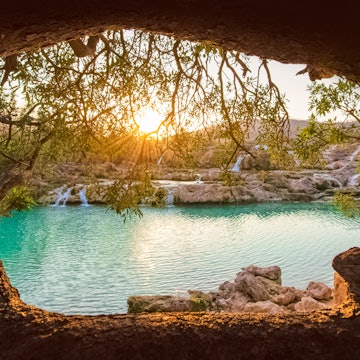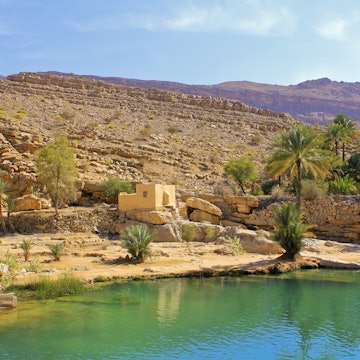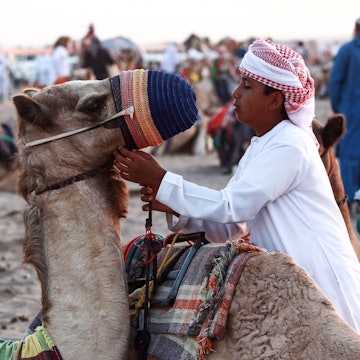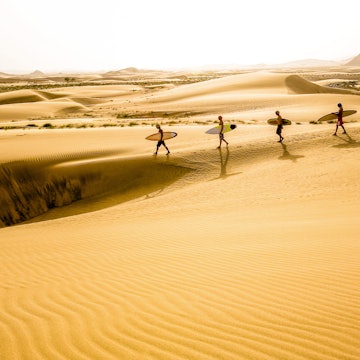

The landscapes in Oman are spectacular, with lush valleys cut across jagged limestone mountains © Marcin Szymczak / Shutterstock
Oman’s cities and towns offer plenty of cultural experiences and historical sights, but the country’s biggest draws – and the sites that knock most visitors’ socks off – lie outside the city limits.
The landscapes in Oman are spectacular. Lush wadis (valleys) cut across jagged limestone mountains, and white-sand beaches hug turquoise waters. The wildlife is diverse: sprightly Arabian gazelles and horned Arabian oryx peer at you atop desert plateaus, rays and dolphins swim in cerulean seas and rare Arabian leopards stay hidden on the rugged mountain slopes.
During the last few decades, Oman has made significant strides in environmental conservation, declaring many of these sites protected nature reserves. Species that were once extinct in the wild have been brought back through breeding and conservation programs, and sustainable tourism efforts are ongoing.
Damaniyat Islands
Best for diving and snorkeling
The azure waters surrounding the Damaniyat Islands – a 100-hectare (247-acre) marine reserve and craggy nine-island archipelago off Oman's northern coast – are wildly popular with divers in the know. It has more than 22 sites suitable for divers of various levels, and nutrient-rich waters that are thick with coral reefs and colorful tropical species, including Arabian butterfly fish, clown fish, puffer fish, rays, eels and turtles. Divers and snorkelers are often rewarded with sightings of whale sharks, humpback whales and pods of dolphins too.
You’re not allowed to disembark on the uninhabited islands from May through October, when green and hawksbill turtles visit to nest and bury their eggs in holes on the sandy beaches. (The islands are also an important nesting site for migratory birds such as ospreys and terns.) But outside of nesting season, it’s easy to visit by boat, from Al Mouj Marina in Muscat or further down the coast at Barr Al Jissah.
Top tip for visiting Damaniyat Islands: Local operators, such as Extra Divers Qantab and MolaMola Diving Center, offer guided snorkeling and diving trips, and can also arrange the permit needed to visit the islands.
6 unforgettable beaches in Oman for every type of traveler
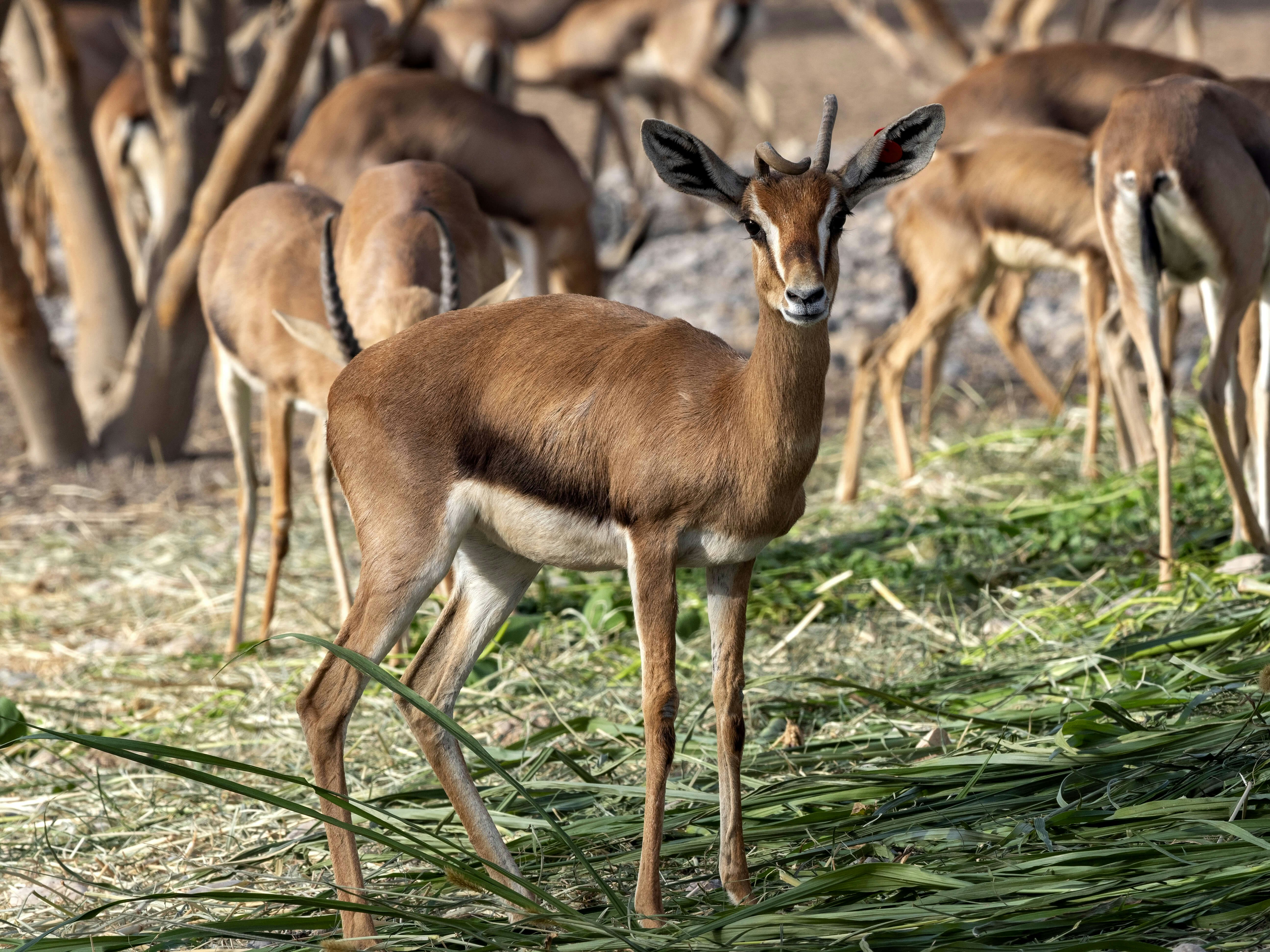
Al Saleel National Park
Best for seeing Arabian gazelles
Designated a nature reserve in 1997, Al Saleel National Park extends across 220 sq km (85 sq miles) in the Ash Sharqiyah South governorate. Forests of acacia and gum trees cover the alluvial plains, and Egyptian eagles and vultures soar above barren wadis and rocky mountainous terrain.
The park is home to more than 30 species of birds, at least eight kinds of reptiles and indigenous wildlife, including Arabian wildcats, red foxes, hares and wolves. Most visitors, however, come to see the Arabian gazelle – nearly 7% of its total population lives here, making Al Saleel National Park an important habitat for the conservation of the species in the region.
Top tip for visiting Al Saleel National Park: Al Saleel is a little less than an hour’s drive from the coastal town of Sur, and it's a good stop on trips from the coast to the desert at Sharqiya Sands, or the pools at Wadi Bani Khalid. Because of changing entry rules and a new safari project nearing completion, call the Environment Authority before you go to see if a permit is required to enter the sanctuary.
Al Wusta Wildlife Reserve
Best for photographing Arabian oryx
Sometimes known by its former name, the Arabian Oryx Sanctuary, Al Wusta Wildlife Reserve is an example of the country's successful efforts towards environmental protection and wildlife conservation during the last decade. What brings most visitors here is the desire to see the elegant Arabian oryx, a desert antelope with slender ringed horns that’s thought to have inspired the myth of the unicorn.
Made extinct in the wild after Oman's last one was killed by poachers in 1972, the animal was reintroduced a decade later, and this reserve of plains, rugged slopes and sand dunes – then known as the Arabian Oryx Sanctuary – was designated a Unesco World Heritage Site. But in 2007, when the government turned 90% of the reserve over to oil drilling – to the detriment of the Arabian oryx and other species, such as the Houbara bustard and Nubian ibex – it became the first place ever to be delisted by Unesco.
Eventually the need to diversify beyond oil revenues turned governmental attention back to wildlife conservation and the subsequent potential of ecotourism, and in 2017, the 2824-sq-km (1090-sq-mile) reserve reopened to the public. Today a herd of some 750 Arabian oryx can be found on the premises, brought back from extinction in the wild through a targeted breeding program. Other species here include the Reem gazelle, Arabian gazelle, striped Hyena, Nubian ibex, Ethiopian hedgehog, lynx, sand cat and Arabian wolf.
Top tip for visiting Al Wusta Wildlife Reserve: You’ll need a 4WD to visit the reserve, as well as a permit from the Office for Conservation of the Environment in Muscat. The only way to enter the reserve to see the animals in the wild is with a guide, available at the reserve.
10 must-see natural wonders in Oman
Jebel Samhan Nature Reserve
Best for dramatic views
At Jebel Samhan, the highest mountain in the Dhofar governorate, cotton-like clouds descend upon craggy mountains crisscrossed by deep canyons and interspersed by pockets of acacia, gum and Boswellia trees. Limestone cliffs, sculpted by erosion, drop steeply towards coastal plains.
Spread over 4500 sq km (1737 sq miles), the Jebel Samhan Nature Reserve is home to some of the last Arabian leopards in the wild, 20 to 30 of which are known to live in the reserve. But given their elusiveness, the likelihood of spotting other species, such as the Nubian ibex, Arabian gazelle, Arabian wolf, caracal, fox, striped hyena and Indian crested porcupine is much higher. The conservation program, launched in 2014, educates herders to stop poisoning, hunting and trapping these rare creatures (illegal since 1976) to protect their livestock and compensates them for any losses.
A stop at the Jebel Samhan Viewpoint is a must – on a clear day, for breathtaking panoramas over the coastal plain, and on an overcast one, to feel like dense clouds are within reach. Keep an eye out for several bird species, such as the Socotra cormorant, which thrive in the steep cliffs in the area. Visitors need to obtain prior permission from the Office of the Conservation of the Environment to visit the reserve.
Top tip for visiting Jebel Samhan Nature Reserve: The reserve is just an hour’s drive from Salalah. Drive carefully during the khareef (monsoon) season from June to September, when it can be foggy, leading to low visibility.

Ras Al Hadd
Best for turtle watching
Five species of turtle – including green, loggerhead and hawksbill – are found in the waters around Oman’s 3165km (1967-mile) coastline, with thousands migrating annually to the beaches here to lay their eggs.
Located in the Ash Sharqiyah South governorate, the shores of Ras Al Hadd and Ras Al Jinz Turtle Reserve are incredibly popular with visitors who come to watch nesting turtles. The reserve conducts guided turtle-nesting tours twice daily: in the evening, when the turtles emerge from the sea to dig holes in the sand and bury their eggs, and at dawn, when they leave their nests behind and return to the sea. (The eggs hatch about 55 days later.)
The green turtle is a species that returns annually to lay eggs at the same beach where it was born, and it's found in large numbers at Ras Al Hadd and Ras Al Jinz throughout the year, though peak season is summer. From May to September, baby turtles hatch out of their eggs and make the long journey across the sand to the Arabian Sea, after (hopefully) thwarting the efforts of preying foxes.
Top tip for visiting Ras Al Jinz Turtle Reserve: For guided tours at Ras Al Jinz, guest numbers are limited, so prior reservations – online or by phone – are a must. Expect tours to be busy on the weekends. To protect the turtles, flash photography is not allowed.
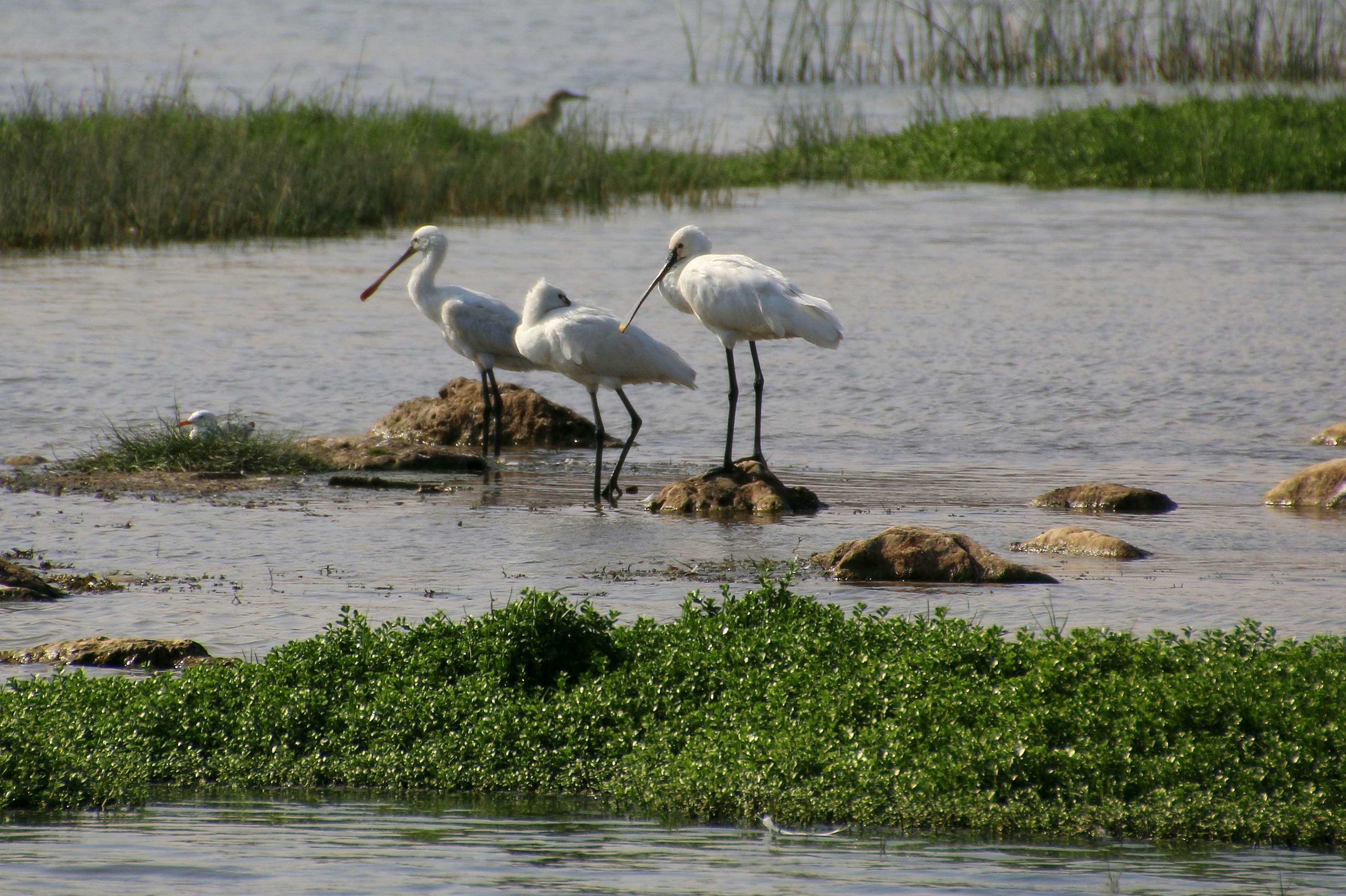
Dhofar Lagoons (Khors of the Salalah Coast Reserve)
Best for birdwatching and history
With valleys and plains turned verdant by the annual khareef (monsoon), the Dhofar governorate attracts scores of visitors in search of a change of scenery from sandy deserts and parched wadis. An easy road trip from Salalah, a group of lagoons lies along the coastline, providing a hospitable ecosystem for hundreds of birds, fish and plants.
Of these, eight – ranging from a few hectares to more than 100 – are protected nature reserves and make up the khors of the Salalah Coast (khor or khawr means “lagoon” in Arabic). Also known as the Dhofar lagoons, the estuaries are prime nesting sites for indigenous and migrating birds, thanks to their rich biodiversity – you can spot flamingoes, herons and egrets here, among other species. Khor Rori, Khor Ad Dahareez and Khor Al Qurm Al Sagheer and Al Kabeer are popular with birdwatchers.
The largest of these is Khor Rori, also worth a visit for the ruins of the fortified city of Sumhuram, once an important port on the region’s ancient frankincense trading route, and the Sumhuram Archaeological Park, which boasts finds dating to the 1st century BCE. Khor Rori is one element of a Unesco World Heritage Site that includes Al Baleed Archaeological Park, located on the site of the 12th-century city of Zafar – another stop on the frankincense trading route – by Khor Baleed, also part of the nature reserve as well.
Top tip for visiting the Dhofar lagoons: To understand Oman’s frankincense heritage, visit the nearby Museum of the Frankincense Land, where artifacts and historic documents tell the story of the area’s settlements and frankincense trade.
You might also like:
The 8 best places to visit in Oman: rugged mountains, seaside towns and culture-rich cities
The top things to do in Oman are out of this world
The best times to visit Oman for blooming roses, racing camels and nesting sea turtles






